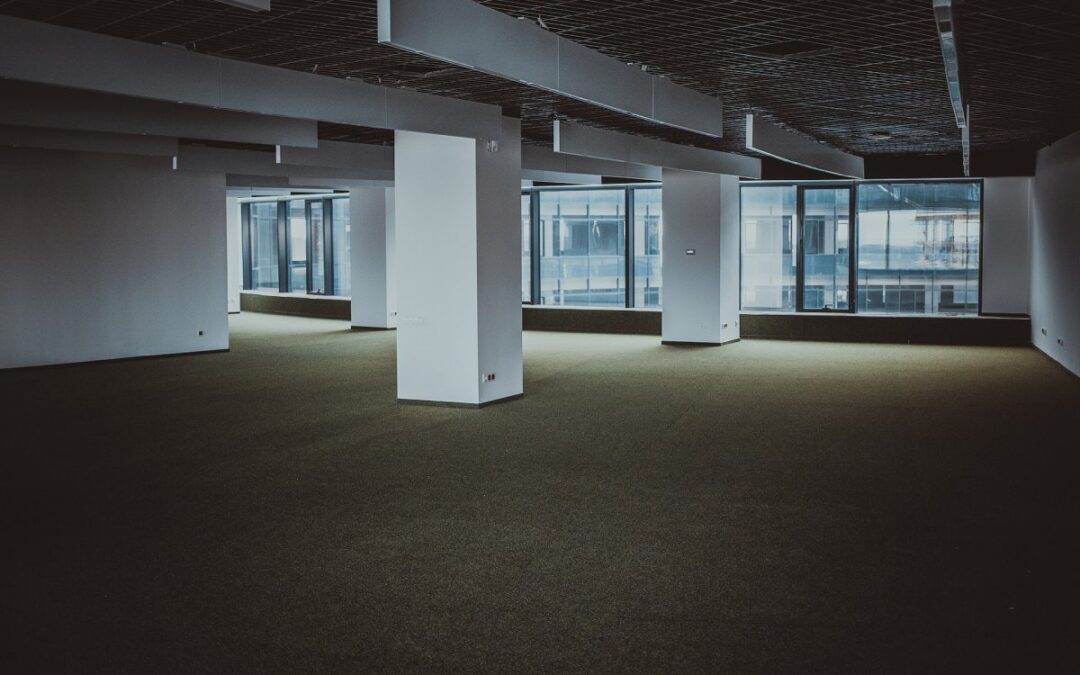When was the last time you heard that phrase? Probably not recently. Between unleased and partially occupied commercial real estate, nationally almost 50% is available. This is a problem on a lot of levels.
For companies who own or lease their own space, the immediate response is to get people back to the office to use the space that they have. This is a sunk-cost fallacy. In the immortal words of Peter Gibbins, “Human beings were not meant to sit in little cubicles” (Office Space). It’s not working for a lot of companies. They need to take a step back and ask the tough question. Is the office we have, the office that we need? Chances are the answer is no. The answer for owners or those with long leases, is chances are you have some planning or negotiating to do. Consult your leasing agent or realtor for suggestions. For this article, we are going to just focus on other ways office space can be used.
For commercial real estate owners and agents, revenues are down and the future looks bleak. Since commercial real estate and banks are closely linked, the risk to the banking industry is real. We’ve seen a couple of large failures in recent months. More are likely if the commercial real estate market doesn’t pick up. Morgan Stanley recently made some dire predictions for the industry. I believe part of the solution is changing the lens of how we look at office space.
Is it just office space?
Labels and perception can make a big difference. Office space has a specific image in most people’s minds. To change the current forecast for office space, we need to look at it differently. It might sound like a daunting task, but there are lots of examples, where we changed the way we looked at something and then it took off. Post It Notes have evolved into a variety of products having started with glue that didn’t work as planned. Febreze originally had a different use that didn’t do well. Once they changed the messaging it took off. And who can forget Sildenafil, a medicine to treat hypertension (high blood pressure) and angina pectoris (a form of cardiovascular disease)? It wasn’t until they rebranded it around one of its side effects, that Viagra took off.
We need to stop calling it office space. It is multi-potential real estate with commercial applications. That probably won’t catch on, but the name will come with time. The key is to look at the space as space and not tie it to the use that it has been used for in the past. There are lots of other uses for this type of real estate than traditional offices. Especially when the demand doesn’t seem to be there.
Retail Space
Some commercial real estate properties can be repurposed for retail use. For instance, a company can convert its former office space into a showroom or store. Realistically, this can only be done on the first couple of floors of a building, but it may make sense for some properties. This is probably not the first choice for many areas since so much shopping has moved online, but every situation is different. Convenience stores or coffee shops or bakeries are likely candidates depending on foot traffic. Other uses may need to come first for most space. But traditional retail space may be part of a larger plan.
Co-working spaces
With the rise of remote work and the gig economy, co-living and co-working spaces are becoming more popular. Landlords can convert commercial office spaces into co-working spaces or co-living spaces that offer temporary accommodation for freelancers or remote workers. There are currently more than 6,200 coworking spaces in the U.S. (2023). This is a 55% growth since 2017. There are approximately 1.08 million people in the U.S. who use coworking spaces. There are usually minimal physical changes required so this can be a relatively quick conversion.
Residential Living Space
Some commercial offices have great views that would make for great apartments. We’ve all seen trendy apartments in converted factories on different TV shows. Office buildings are a little harder to convert, primarily because of the plumbing. Changing to a distributed plumbing and HVAC system can be very costly. But if the demand is there, developers will find a way. A lot will depend on the original building infrastructure. Commercial properties can also be converted into hotels or serviced apartments.
Warehousing
Commercial real estate properties can also be used for warehousing, storage, and distribution centers. Each of these has different models. New development of storage facilities has slowed because of interest rates, but repurposing buildings may defray some of these costs. As an industry, self-storage is currently valued at about $54 billion and is projected to grow about 7% over the next few years. Amazon has scaled back on its warehouse building spree, but reused office space may be a good fit for some retailers in urban markets.
Entertainment Venues
Some office buildings can be converted into entertainment venues like theaters, movie halls, music venues, or dance halls. These can be cool spaces. I’ve been in a couple venues that work well. Thomas Hooker Live is a great venue that makes good use of converted space. As long as the market is there, this can be a great addition to any commercial space.
Data Centers
With the increased demand for cloud computing and data storage, commercial properties can be converted into data centers. With cloud growth expected to almost triple from 2020-2025, this is a logical fit. And it’s perfectly designed for commercial real estate. It’s just a matter of finding the right tenant.
Microgrids
This requires a little forethought because the technology is really emerging. Some of the larger players in the market are Bloom Energy and Tesla but others are flooding into the market. With blackouts in many areas over the past few years, microgrids are starting to become more popular. Paired with wind or solar, there are lots of opportunities for sustainability.
Healthcare
Some commercial real estate properties can be repurposed into medical facilities like hospitals, clinics, or labs. Physically there is usually minimal conversion required, and there is a need for more accessible medical facilities. Sadly the medical industry is struggling right now. Waits in hospitals are measured in hours and forget about going to your primary care provider if you are sick. It’s a broken market in an area where the need is very strong. The number of doctors seems to be part of the problem. There are still plenty of sick people needing services.
Vertical Farms
Vertical farms are probably my favorite commercial space reuse. Indoor farming has taken off thanks to LED lights which make growing indoors more cost-effective. The size of the market is expected to be over $35 billion within 10 years. Vertical farms can be built on-site to take advantage of specific floorplans. Or they can be pre-fabricated in containers and loaded into the building. Besides the fresh produce year-round, there may be agricultural tax incentives as well. Since many urban areas are classified as food deserts there are also a variety of federal programs that may be available to both build the farms and sell the produce. Also, most vertical farms grow in the air so no need for soil.
Final Thoughts on Office Space
I don’t expect multi-potential real estate with commercial applications to catch on as a term. The bottom line is it doesn’t have to be office space anymore. Hopefully, you’ve thought of other ideas. When we think of office space, we really should just think of the movie. So let’s get back to work – somewhere other than the office. “I’m going to need those TPS reports ASAP”.



